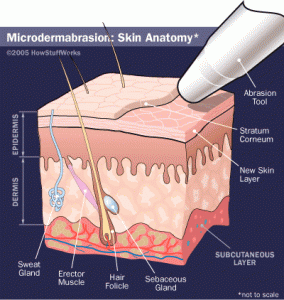Micro Dermabrasion
An effective alternative to costlier and more invasive procedures like plastic surgery and botox. It’s being advanced as an “instant facelift”.
Microdermabrasion is the application of tiny rough grains to buff away the surface layer of skin.
Your skin is made up of two main layers, the epidermis and the dermis. The epidermis is the layer closest to the outside world. It’s a set of dead skin cells on top of another layer of cells that are in the process of maturing. The topmost layer is called the stratum corneum. The stratum corneum mostly acts as a barrier between the outside world and the lower skin layers. It keeps all but the smallest molecules from getting through.

When you put lotions or creams on your skin, some of the moisture passes through the stratum corneum, but not all of it. This layer is home to many minor skin imperfections like fine wrinkle lines and blemishes.
All of the action in microdermabrasion takes place at the level of the stratum corneum. Since it only really targets the epidermis. Affecting deeper layers of skin would be painful and harmful, and it would risk permanently embedding the tiny grains into the skin.
When you remove or break up the stratum corneum , the body interprets that a mild injury has taken place and rushes to replace the lost skin cells with new and healthy ones.
What effects may I experience?
In the first hour after treatment you may experience mild swelling and redness. Depending on the individual, these side effects can last anywhere from an hour to two days.
What are the benefits of this treatment?
This process has a few beneficial effects
- The skin’s surface is improved.
- The healing process brings with it newer skin cells that look and feel smoother.
- Reduces skin imperfections like sun damage, blemishes and fine lines.
- Allows better penetration of active ingredients in moisturisers.
What is the long term effect of Microdermabrasion?
Repeated microdermabrasion treatment at regular intervals influences the way the lower layers of skin grow, as well, removing deeper blemishes over time. The rapid loss of skin moisture triggers the lower skin layers to work overtime in speeding healthy cells up to the surface.